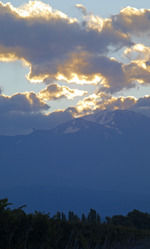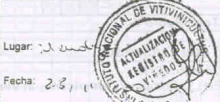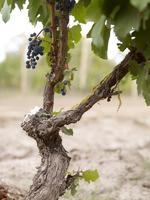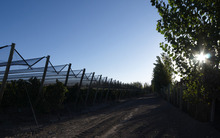Nature's Helping Hand
Nature gives us opportunities, often disguised as challenges.
 Mendoza is in the ‘rain shadow’ of the Andes: from the Pacific, predominant westerly winds begin dropping their moisture as they ascend the Chilean side of the mountain range, and have precious little left by the time they reach the Argentine foothills. The disadvantage of this is that all of Mendoza’s vineyards must be irrigated to survive. The advantage is that vines grow in conditions with little disease pressure reducing the need for pesticides. It also means that viticulturists and winemakers can regulate the amount of water a vineyard will receive; and how and when.
Mendoza is in the ‘rain shadow’ of the Andes: from the Pacific, predominant westerly winds begin dropping their moisture as they ascend the Chilean side of the mountain range, and have precious little left by the time they reach the Argentine foothills. The disadvantage of this is that all of Mendoza’s vineyards must be irrigated to survive. The advantage is that vines grow in conditions with little disease pressure reducing the need for pesticides. It also means that viticulturists and winemakers can regulate the amount of water a vineyard will receive; and how and when.
With roots deeply established, and as high quality producers, Versado elects to irrigate very sparingly in order to obtain the finest quality wine. (Matters of timing, volume, duration, location, dispersal, extent and a host of other things make it much more complex than that - but the gist of it is that it is essentially under our control.)
A great benefit of our site specifically, is its location in an area where cool, clean meltwater from the high Andean glaciers can be provided to the vineyard. Much of Mendoza - famously - is “furrow irrigated,” but our vineyard’s high elevation and our location immediately below the region’s largest fresh mountain water supply, in Potrerillos, ensures a water channel that is still cool and clean. By contrast, irrigation waters that have flowed over countless hectares of farmland bring with them not only unwanted weed seeds, but also the untold spray contaminants of dozens of conventional farms upstream. Particularly for Versado, as winegrowers convinced of the qualitative benefits of organic farming, access to fresh, clean melt-water is a fortuitous blessing.
Age matters.
 Another element often cited as one of the most critical in the production of the greatest wines is the age of the vines from which they are produced. Recognizing this long ago, the Argentine government implemented an excellent system to provide written certification of a vineyard planting’s age through documentation created and maintained by the grape and wine industry’s regulatory authority, the INV. The Versado vineyard’s planting all dates from the year 1920. At a hundred years of age, the naturally reduced yields of grapes, and the increased intensity and complexity of their flavours, play a significant role in the final quality of Versado’s wine.
Another element often cited as one of the most critical in the production of the greatest wines is the age of the vines from which they are produced. Recognizing this long ago, the Argentine government implemented an excellent system to provide written certification of a vineyard planting’s age through documentation created and maintained by the grape and wine industry’s regulatory authority, the INV. The Versado vineyard’s planting all dates from the year 1920. At a hundred years of age, the naturally reduced yields of grapes, and the increased intensity and complexity of their flavours, play a significant role in the final quality of Versado’s wine.
 With the exception of less than 1% Tempranillo, sparsely interspersed, and an even smaller quantity of Cabernet Sauvignon, Versado’s vineyard is planted to Malbec - the signature grape of Argentina. It is plantings of this era that, in fact, helped established that reputation.
With the exception of less than 1% Tempranillo, sparsely interspersed, and an even smaller quantity of Cabernet Sauvignon, Versado’s vineyard is planted to Malbec - the signature grape of Argentina. It is plantings of this era that, in fact, helped established that reputation.
What further distinguishes our vines is the fact that each of them contains entirely European genetics. Like all vines grown in Europe prior to the devastating phylloxera epidemic of the mid-19th century, all of Versado’s vines grow “ungrafted,” on their own roots. Because they are not grafted to the phylloxera-resistant rootstocks of native North American grapevines, as the vast majority of the world’s vines now are (more than 99%), our ancient Malbec vines potentially provide the purest expression of this classic grape variety.
A different kind of safety net.
 One quality factor in our vineyard, however, relates not to age, climatic or geographic reasons, but to our own recent intervention. Prior to purchasing the vineyard, we realized that the same cool air flow that gives the vineyard its greatness, also, unfortunately, brings far too frequent hail to the area. (Achaval-Ferrer’s famed Bella Vista Vineyard - the vineyard immediately to our north, between us and the Rio Mendoza, and virtually the highest rated wine in Argentina over the last decade - had no 2005 or 2006 wines due to devastating hail damage!)
One quality factor in our vineyard, however, relates not to age, climatic or geographic reasons, but to our own recent intervention. Prior to purchasing the vineyard, we realized that the same cool air flow that gives the vineyard its greatness, also, unfortunately, brings far too frequent hail to the area. (Achaval-Ferrer’s famed Bella Vista Vineyard - the vineyard immediately to our north, between us and the Rio Mendoza, and virtually the highest rated wine in Argentina over the last decade - had no 2005 or 2006 wines due to devastating hail damage!)
To solve this issue at Versado, we went to the extreme expense of covering our entire vineyard with overhead netting; we did it on tall wooden posts, three metres up, so as not to interfere with our all-important air flow. As a direct benefit, not only does the netting stop hail stones, it intercepts approximately 3% of the sun’s ultraviolet rays, so our wines’ pH is tweaked favourably by another fraction, complementing the already-excellent moderation of our cool air corridor. (And some protection from marauding birds, and the damaged, infected berries that often result from their pecking, is a further advantage provided by the netting.)

